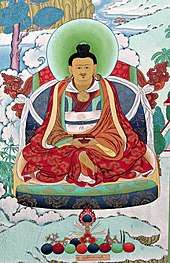Tertön
Tertön (Tibetan: གཏེར་སྟོན་, Wylie: gter ston )[1] is a term within Tibetan Buddhism meaning a person who is a discoverer of ancient hidden texts or terma. Many tertöns are considered to be incarnations of the twenty five main disciples of Padmasambhava (Guru Rinpoche), who foresaw a dark time in Tibet. He and his consort Yeshe Tsogyal hid teachings to be found in the future to benefit beings.[2] A vast system of transmission lineages developed. Scriptures from the Nyingma school were updated by terma discoveries, and terma teachings have guided many Tibetan Bon and Buddhist practitioners.
The Termas are sometimes objects like statues, and can also exist as dharma texts and experiences. Tertöns discover the texts at the right time and place. The teachings can be relatively simple transmissions as well as entire meditation systems. Termas are found in rocks, water and the minds of incarnations of Guru Rinpoche's students.[3]
Prominent tertöns
According to generally accepted history, the rediscovering of terma began with the first tertön, Sangye Lama (1000–1080). Tertöns of outstanding importance were Guru Chowang (1212–1270), Rigdzin Gödem (1307–1408), Dorje Lingpa (1346–1405), Ratna Lingpa (1403–1478), Pema Lingpa (1450–1521), Namchö Mingyur Dorje (1645–1667), and Jigme Lingpa (1729–1798), Jamyang Khyentse Wangpo (1820–1892) and Orgyen Chokgyur Lingpa (1829–1870).
The 15th Karmapa Khakyab Dorje of the Karma Kagyu Lineage was a tertön. There was a prophesy from Yeshe Tsogyal that he should take tantric consorts. Initially he wished to stay a monk, but his health was failing. Meditation masters told him he would die if he didn't fulfill his functions as a tertön. In 1892 he was convinced to marry when he was 20 years old. By the time the 15th karmapa died, he had accumulated 40 boxes of termas, texts and objects.[4]
Another noteworthy tertön is Tsangpa Gyare, founder of the Drukpa Lineage (12th century).
The "seal" of all tertöns is said to have been Jamyang Khyentse Wangpo (1820–1892). In one of his visions, he could clearly see all the terma that were hidden throughout Tibet and other countries. He was the only master in Tibetan history to have not only received, but also transmitted the "seven transmissions" (bka' babs bdun), that are the canonical teachings, treasures taken from the earth, reconcealed treasures, mind treasures, recollections, pure visions, and aural transmissions received in visions. (Ricard, undated).
 Guru Chowang
Guru Chowang- Ridzin Gödem
 Dorje Lingpa
Dorje Lingpa- Ratna Lingpa

The Five Tertön Kings
Throughout the centuries many more people were known as tertön. Five of them were widely recognized as very important ones and called the "five tertön kings:"
- Nyangral Nyima Özer (1124–1192)
- Guru Chökyi Wangchuk (1212–1270)
- Dorje Lingpa (1346–1405)
- Pema Lingpa (1445/50–1521)
- Jamyang Khyentse Wangpo (1820–1892)
 Nyangrel Nyima Ozer
Nyangrel Nyima Ozer Gendun Chokyi Wangchuk
Gendun Chokyi Wangchuk Dorje Lingpa
Dorje Lingpa

The Eight Great Lingpas
The Eight Great Lingpas (Tibetan: གླིང་པ་བརྒྱད་, Wylie: gling pa brgyad ) were eight important tertöns in the Nyingma lineage of Tibetan Buddhism. They are listed as:[5]
- Rinchen Lingpa (1295–1375)
- Sangye Lingpa (1340–1396)
- Dorje Lingpa (1346–1405)
- Ratna Lingpa (1403–1471)
- Kunkyong Lingpa (1408–1489)
- Pema Lingpa (or Padma Lingpa) (1445/50–1521)
- Tennyi Lingpa Padma Tsewang Gyalpo (1480–1535)
- Jamyang Khyentse Wangpo (1820–1892)
Tertön practices
Consorts, with whom they practice sexual yoga or karmamudra to accelerate and enhance their capacity for realization, are thought to be very important to tertöns.[6] Fremantle (2001: p. 19) states that:
One of the special requirements for the discovery of termas is the inspiration of the feminine principle, just as it was necessary for their concealment. The great majority of tertöns have been men, and generally they are accompanied by their wives or female companions (who need not necessarily have a sexual relationship with them). Alternatively, something representing the tertön's complementary energy, whether male or female, must be present.[7]
Yet, even very realized female practitioners bring forth terma, sometimes with an living male consort and sometimes alone. Dakini Sera Khandro is a notable example of a woman tertön.
Although the authenticity and value of a terma may be questioned or debated, tertöns are exempt from being judged according to their behavior and lifestyle, with Guru Rinpoche having cautioned that “hidden enlightened beings appear in uncertain form” and, by contrast, “fool-deceivers are great hypocritical mimics of the dharmic practitioner”.[8]
References
- "Tibetan-English-Dictionary of Buddhist Teaching & Practice". Diamond Way Buddhism Worldwide. Rangjung Yeshe Translations & Publications. 1996. Archived from the original on 2010-03-28. Retrieved 2011-02-05.
- Gobel, Detlev and Knoll, Claudia, "The Tantric Consorts and Children of the 15th Karmapa, Buddhism Today, Spring/Summer 2020 issue 45 p 41
- Gobel, Detlev and Knoll, Claudia, "The Tantric Consorts and Children of the 15th Karmapa, Buddhism Today, Spring/Summer 2020 issue 45 p 41
- Gobel, Detlev and Knoll, Claudia, "The Tantric Consorts and Children of the 15th Karmapa, Buddhism Today, Spring/Summer 2020 issue 45 pp. 41-42
- "gling pa brgyad". Rangjung Yeshe Wiki. Rangjung Yeshe. 2011-09-29.
- Courtesans and Tantric Consorts: Sexualities in Buddhist Narrative by Serinity Young; p155
- Fremantle, Francesca (2001). Luminous Emptiness: Understanding the Tibetan Book of the Dead. Boston: Shambhala Publications, Inc. ISBN 1-57062-450-X. p. 19.
- Tulku Thondup Rinpoche, Hidden Teachings of Tibet: An Explanation of the Terma Tradition of the Nyingma School of Buddhism, Wisdom Publications, London, 1986, p. 157. ISBN 086171041X
- Trungpa, Chögyam (2005). Interview With Karma Senge About Kyere Gompa. Accessed January 9, 2007.
External links
